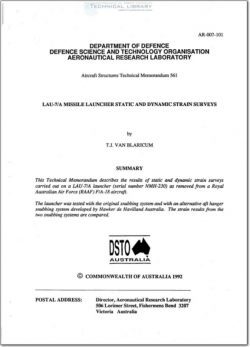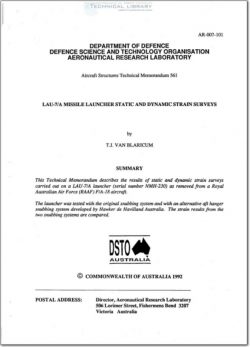DSTO-AR-007-101

- Version
- 111 Downloads
- 1.88 MB File Size
- 1 File Count
- August 10, 2016 Create Date
- August 10, 2016 Last Updated
LAU-7A Missile Launcher Static and Dynamic Strain Surveys

A number of LAU-7/A launchers on Royal Australian Air Force (RAAF) F/A—18 aircraft
had been found to have fatigue cracks in the guide rails at the forward missile hanger
location. The LAU-7/A launcher supports the AIM 9L Sidewinder missile on the
wingtips of the F/A-l8. The fatigue cracking was observed to begin at low hours in
service (200 to 600 flying hours) and was attributed to poor snubbing (locking in place
on the launcher rail) at the aft missile hanger.
At the request of the RAAF, the Aeronautical Research Laboratory (ARL) was
commissioned to develop a repair scheme to enable cracked launchers to be salvaged and
returned to service. A repair was developed and fatigue tested (Ref. 1). That repair
involved machining away the damaged rail section. A replacement rail section, consisting
of a machined aluminium plate which restored the original rail profile was then bolted in
place on the launcher. Implementation of the repair on a number of launchers in service
on RAAF F/A-18 aircraft has proved to be successful to date.
Hawker de Havilland Australia (HDH) were commissioned by the RAAF to design an
improved snubbing system that carried a greater share of the missile inertia loads at the
aft hanger thereby preventing or reducing the incidence of cracking at the forward hanger
location.
Vibration tests were carried out at the Defence Science and Technology Organization
(DSTO) Vibration Laboratory at Salisbury, South Australia. Those tests used launcher
serial number 422B fitted with a dummy Aim 9L missile. Launcher 422B was fitted with
the HDH snubber. No strain gauges were fitted. The tests indicated that the HDH snubber
did not prevent cracking of the launcher at the forward hanger location. The life to crack
initiation was similar to that for RAAF F/A—18 aircraft usage. Fractographic analysis of
the cracked launcher (No. 422B) by ARL has been reported previously (Ref. 2).
| File | Action |
|---|---|
| DSTO-AR-007-101 LAU-7A Missile Launcher Static and Dynamic Strain Surveys.pdf | Download |
Comment On This Post